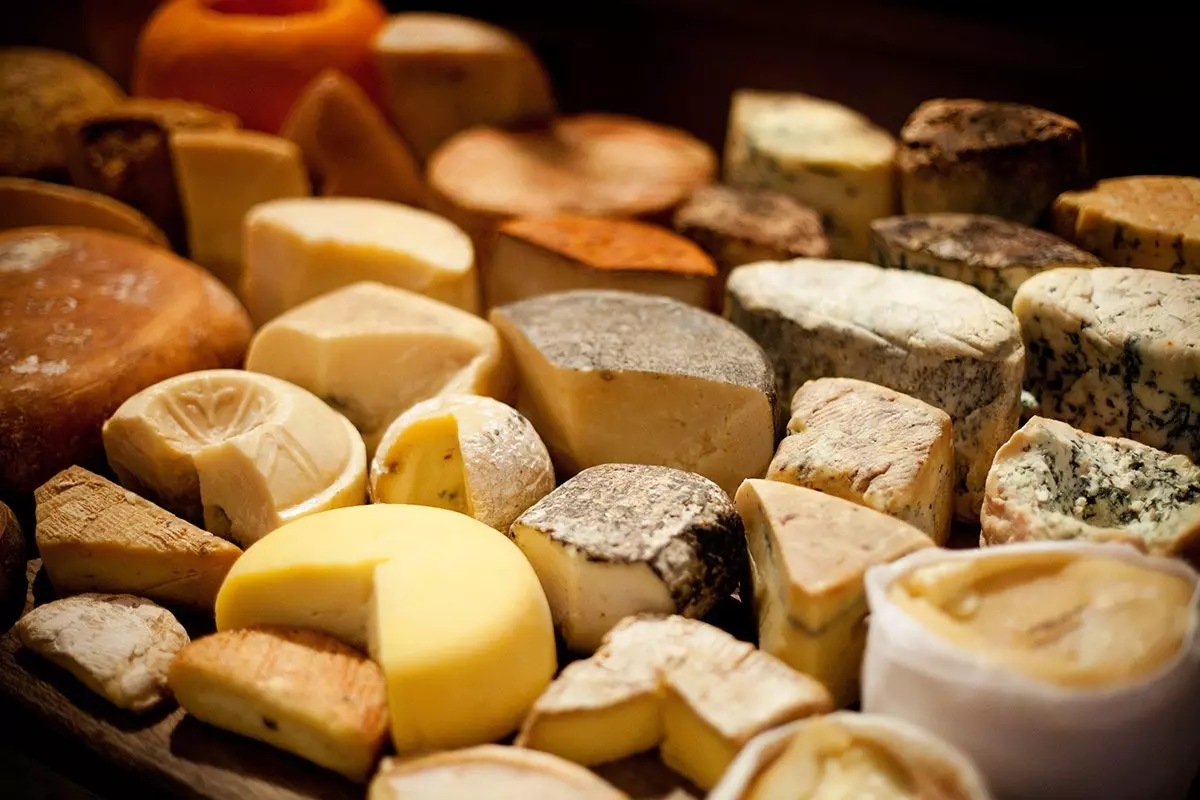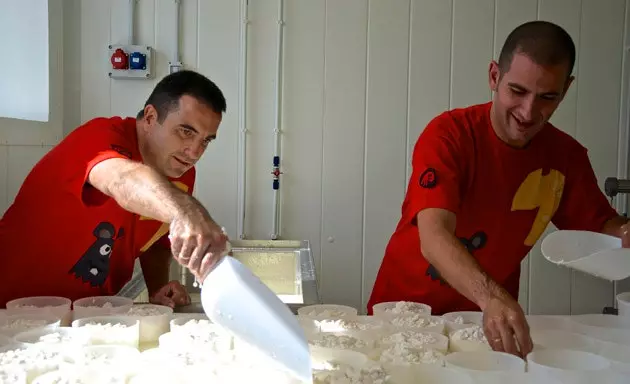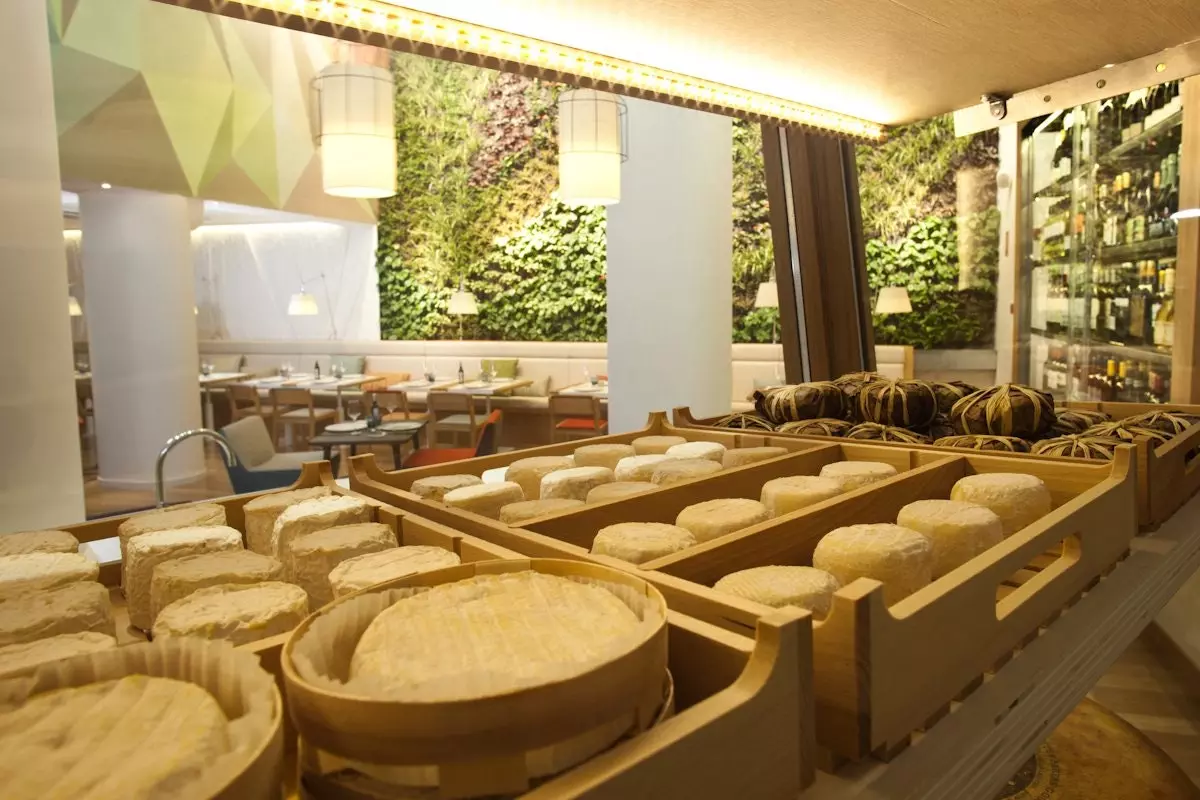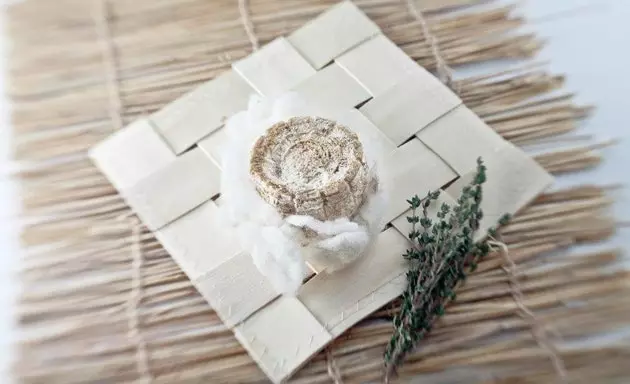
Santceloni cheese cart (Madrid)
We have interviewed one of the people who know the most about the subject in our country. Lover of putrid cheeses, **the maitre d' at the bi-star restaurant Santceloni, ** Abel Valverde , has explained to us how much Spain paints in this cheese and what you cannot miss in the world. So he puts aside the pata negra ham (it will only be a parenthesis) and dive into the fragrant world of cheese without complexes. We give you the clues so that you have the coordinates of a trend that is here to stay.
GUIDE TO NOT BEING 'OUT CHEESE'
Where to start? Nothing better than reserving a table at the Sanceloni restaurant. If there is a temple of the cheese board in Spain (properly understood), it is this. about 80 varieties (sometimes with a monograph dedicated to one of them) they rotate and vary on this 1,800 cheese table brought from an old pagés house, from the Ampurdá area. As soon as you walk through the door, you will already smell cheese.

Abel Valverde, maitre de Santceloni restaurant.
Cheese lovers grow without stopping. All good things are imitable. The world of cheeses in Spain has been gaining followers. But, as much as we think that a lot of cheese is consumed in our country, the reality is that what has conquered the heart of the average Spaniard (and his fridge) is the effluvium of the image of Don Quixote and his Manchego cheese. In Spain, average consumption stands at 8.02 kilos per person per year , according to sources from the Ministry of Agriculture. But we are not even among the top ten cheese-mad countries: the Greeks are in the lead with 37 kg per person per year, followed by the French (23 kg), Maltese (22 kg), Germans (20 kg. ), Austrians (18 kg.), Cypriots (16 kg.), Argentines (14 kg.), Australians (10.5 kg.) and British (10 kg.)
Who were the pioneers in our country? Santi Santamaria It was the forerunner of cheese boards as God intended (that is, French style) in haute cuisine restaurants, offered and presented to the customer for the service. First it was in his restaurant Can Fabes and then in Santceloni in Madrid, a whopping 10 years ago.

The maitre d', Abel Valverde, and the chef, Óscar Velasco, making the Spirit de Santceloni cheese
Artisans to power In Spain, cheese artisans have always existed but, far from large urban centers and with little marketing, nobody knows them. The coming trend is Hand in hand with heavyweights of the Spanish restoration, these artisan cheeses take their rightful place . At the head of this revolutionary movement, once again the Santceloni restaurant: the Sprit de Santceloni It is a cheese that is the result of collaboration between rural cheese artisans in Spain and haute cuisine restaurants. When Abel Valverde met Rubén, the manager of the Granja Cantagrullas Cheese Factory (in Robledo, Valladolid) he felt that he had found his cheese-making soul mate: “It is the first farm in Spain with permission to make raw sheep's milk with a very French," he tells us. A dream come true.
Spain, in the first division Charles De Gaulle used to say, “How do you expect a one-party system to work in a country with more than 246 different kinds of cheese?” He was talking about France (of course), which borders on 400 varieties. Although in Spain we do not reach those astronomical figures, "we have many unknown products that do not come from very specific rural areas," explains Valverde. Cows to the north, sheep in the center and goats to the south could outline a study of the typology of cheeses in our country (and why not of other types of studies) . But if we have happy animals, excellent weather and we feed these animals well, why doesn't anyone dare to make cheeses with washed paste and moldy rind and we only dare to make cured ones?
Where can I taste the best cheeses? In Madrid, the ideal place to do it is Cheese Bar (José Abascal, 61; tel. 913 99 25 50), the first place in the world dedicated entirely to the world of cheese. With a variety of 170 cheeses (from the 17 Spanish communities and 8 European countries) they have a bar like sushi, where the master tuners prepare the selection of cheeses, a menu oriented to the world of cheese with raclette, _foundues..._According to the chosen type, the service is accompanied by jams, chutneys, quinces, vegetables, jams and a bread to lick your fingers . More than 700 square meters in a place designed to relax, with an interior vertical garden, with a bar and two rooms (one with a Nordic-style communal table).

Inside the Cheese Bar
And buy them? Undoubtedly, the most exclusive cheese boutique is Poncelet (Argensola, 27), a place of contact between artisans and consumers so that they can be initiated into the secrets of cheese (80 Spanish references and more than 240 European ones), including cheeses very exclusive and difficult to find in Spain, even in their country of origin. They are the first distributors to have a Cheese Tuning Center. They buy at origin and their products spend a season in their caves, evolving to their perfect degree of tuning. Let yourself be advised by professionals and get your informative guide. Its courses, tastings and product presentations attract more and more people.

The design and careful presentation of Poncelet cheeses make them, if possible, more appetizing
Another classic in Madrid is La Boulette in the Mercado de la Paz, a market with an iron structure from 1882 that houses this business where you also have very special nuts, wines and breads. In the Mercado de San Miguel, with a more commercial point, you will also find some representation. In Barcelona, In Vila Viniteca (Aguilers, 7) there are more than 350 types of artisanal cheeses, the majority made with raw milk, from different countries and origins, at the right point of refining.
Anything else I should know? Of course! Maitre Abel Valverde recommends us to discover many of our cheeses, which remain hidden. Here are 5 varieties that you should discover:
1)Few knew Gamonéu, a type of blue cheese elaborated in the village of the same name, in the council of Onís and in some places of Cangas de Onís, until one day an anonymous and foreign traveler began to speak of it beyond our borders. Today it begins to stand out internationally.
two. Uga Goat and Sheep Scarf Cheese Made by Finca de Uga (Lanzarote), it won one of the International Cheese Awards last year, proving that its sheep and goats really relax with music in the pens, and that it's not nonsense.
3. At the beginning of the 1990s, nobody had heard of the ** Cadiz Payoyo **. Today the payoya goat, from the Sierra de Grazalema and the Serranía de Ronda, in danger of extinction, has become the goose that lays the golden eggs in these regions.
Four. Among the most recognized are Goat cheeses from Castilblanco de los Arroyos , called Mare Nostrum, a small town in the Sierra Norte de Sevilla that, after a long journey through French lands, implements the careful techniques learned at the Center Fromager de Carmejane, in French Provence.
5. The cheeses of the Aran Valley. In this area (cradle of our cheese specialist) there are many artisans who make cheeses of exceptional quality. To name a few, the Montseny area (Formatgeria del Montseny) produces washed-rind cheeses with spectacular beer.
Where can I learn more about cheese?
The Poncelet Cheese Bar library organizes workshops on weekends (from October to March) with experts in the world of cheese: cheese artisans, sommeliers, chefs... Sommelier Alex Patullé will teach how to find harmony between cheeses and beers from abadía and Ricardo Martínez, from Moulin Chocolat, will explore, together with Paco Pajares, the chef at Poncelet Cheese Bar, the possibilities of introducing cheese as a confectionery ingredient. How cheese is related to oil or how to introduce it in salads will be more topics to treat, between the how not sessions dedicated to its origin (Asturias, the two Castillas, northern Italy, etc.) or according to the animal (cow, sheep, etc.). The basic course on cheese and sensory analysis will be reissued (courses from 22 euros per person)
And how do I make a good cheese board? If you want to surprise your friends, a good cheese board is a safe bet. The important thing is to have a varied selection. Make it visible, appetizing and elegant. Use a variety of colors and flavors to get an experience. The cheese should be cut depending on the shape it has. The keys to this are texture and flavor. The cheese board should have the softer cheeses on the outside and the stronger cheeses on the inside to be eaten last. You will find an excellent list to get to know them virtually in Mundo Quesos.
